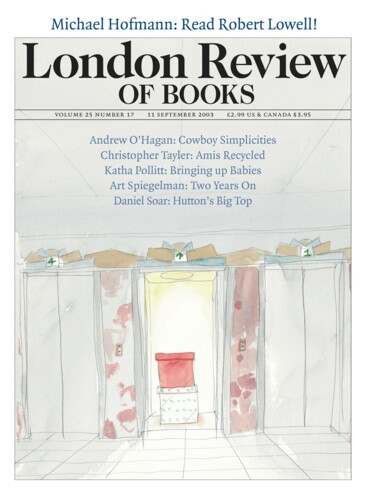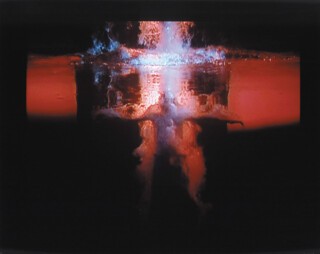New equipment has made video a state-of-the-art art which is shown, very often, on a flat bright screen. Fourteen works by Bill Viola will be exhibited at the National Gallery from October until January – The Quintet of the Astonished, which took as a starting point Hieronymus Bosch’s Christ Mocked, was much admired when it was shown there in 2000. The clarity and sharpness of the images on the screen in which heads changed in slow motion – so slow that it took a moment or two to realise that they were moving at all – was as far from the blurred black and white videos produced in the 1960s and 1970s as Fox Talbot’s earliest photographs are from the detailed prints made by the likes of Beato a few decades later.
The work exhibited in Video Acts: Single Channel Works from the Collections of Pamela and Richard Kramlich and New Art Trust, at the ICA until 19 October, was mostly made between the late 1960s and early 1980s. It takes you back to the origins of the medium. These are video incunabula, blurred, crudely lit and shaky, like images from CCTV cameras or movies of flying saucers. Some are party tricks: William Wegman sitting naked to the waist pushes his stomach in and out, changing the shape of his navel/mouth from an ‘o’ to a ‘-’ as the soundtrack follows with ‘oh’s and ‘mmm’s and his nipples take on the character of staring eyes. Many break taboos. Mild ones – videos of performances in which naked people carry out repetitive actions – and a few strong ones: in one, blood trickles from the cuts as a blade is drawn over a belly to outline a star. Unlike movies, these videos rarely tell a story. Though they exist in time and change as you watch, they make low demands on consecutive attention. You are expected to wander by, not to see the whole thing – many are loops without beginning or end.
Early video art was very often a way of recording performance art. Now more of it takes the form of pictures which move but which are not, in the ordinary sense, moving pictures. The piece which most clearly points that way in the ICA show is Bill Viola’s The Reflecting Pool. It shows just that: a rectangular pool in the woods, squarely in front of you. The position of the camera does not change. A man arrives and stands on the edge opposite. He leaps in the air, but instead of splashing into the water hangs, frozen in time, over it. He slowly fades, while on the pool – in another time frame as it were – ripples appear and disappear. A shadowy couple move across the picture. A naked man unexpectedly emerges from the water and walks off into the woods. The image – this one is projected onto a wall – is rather soft. The whole effect is as calm and shady as a late Corot of bathers among trees. Closer to a painting than a story. You appreciate what you see without asking what is going on, any more than you ask very seriously what is going on with Manet’s couples having lunch on the grass. It’s agreeable, lightly mysterious and rather pretty.
Go from the ICA to the fifth level of Tate Modern and you can see what new technology has made possible. Most impressive is the big dark room where Viola’s Five Angels for the Millennium shows on five screens, each one about the size of a large Rothko (one is illustrated here). It has a lot in common, structurally, with The Reflecting Pool. Ripples spread and bubbles rise to watery sounds which, from time to time, reach a crescendo like a breaking wave. Then a figure blurred by turbulent water rises up through the troubled surface. It looks as though underwater footage of someone dropping into a pool has been reversed. The effect is, again, slightly mysterious. Soothing passages in slow motion are punctuated by bursts of activity. Film-makers use slow motion to heighten the effect of significant moments – a lingering kiss, an explosion, a car tumbling over a precipice. Viola sets his climaxes in a sea of slow motion. Standing in the dark your eyes gradually become aware of people standing or sitting patiently around you. That is how you find them among the Rothkos – another magnet for contemplatives.
Around the corner are Bruce Nauman’s assembled screens – a pair with talking heads, another with jumping clowns, a whole group with actors playing and replaying a domestic argument – and Paul McCarthy’s Rocky, in which, gloved up, the artist hits himself. In Shaman-Girl’s Prayer Mariko Mori, in platinum wig and silver plastic suit, stands in Osaka airport turning a crystal ball in her hands. The video she has made of herself is projected on the wall of a cubicle the size of a small room. Her face – the make-up doll-like, the eyes iridescent – sometimes fills it from floor to ceiling.
The hardest aspect of the visible world to intuit from the evidence of photographs (or reproductions of photographs or videos) is the nature of surfaces. You would be hard put to know from a photograph alone how it felt to stroke a cat or let dry sand run through your fingers. Looking at the real thing you have a better idea. The surface of paintings you never actually touch cannot be fully experienced in reproduction either. Awareness of the smooth page clouds the difference between varnished and unvarnished oil paint, between opaque and transparent watercolour. I didn’t see many paintings of any quality until I was in my twenties, but knew lots from illustrations. The real thing turned out to be rougher, smoother, brighter, duller, larger and smaller than I had assumed. It was much easier to see how paintings had been made: they became both more wonderful and more explicable. This was not a matter of relic-worship, of the accident of uniqueness. It applied to etchings and lithographs which, in some cases, existed in thousands of copies. Nor, in theory, did it preclude the possibility of perfect reproduction, although most ‘facsimiles’ prove, even on cursory inspection, to be anything but. When William Gibson’s science fiction machines which reproduce objects molecule by molecule arrive, the magic residing in the true original will be in the mind alone.
The Tate videos sit among paintings in one of the thematic displays: ‘Nude/ Action/Body’ is an unsatisfactory mélange but it offers a chance to compare non-virtual art and the art of the digital file. It becomes clear that the extra information in the painted images, even to a degree in the photographed ones like John Coplans’s black and white prints, can bear being looked at for longer. There are colours the projector cannot match, there is information about how the painter used his hands, how he responded to the task of showing what an eye or a foot looks like, how he chose to edit out, exaggerate or formalise. The Rothkos, downstairs at the Tate, are remade in the mind as the conclusion of human acts and decisions in a way a video can only partly match. All these videos, many explicitly, even intrusively, about the human body, tell you less about the experience of having hands, eyes and a brain than a painting of a jug and plate often can.
Send Letters To:
The Editor
London Review of Books,
28 Little Russell Street
London, WC1A 2HN
letters@lrb.co.uk
Please include name, address, and a telephone number.


